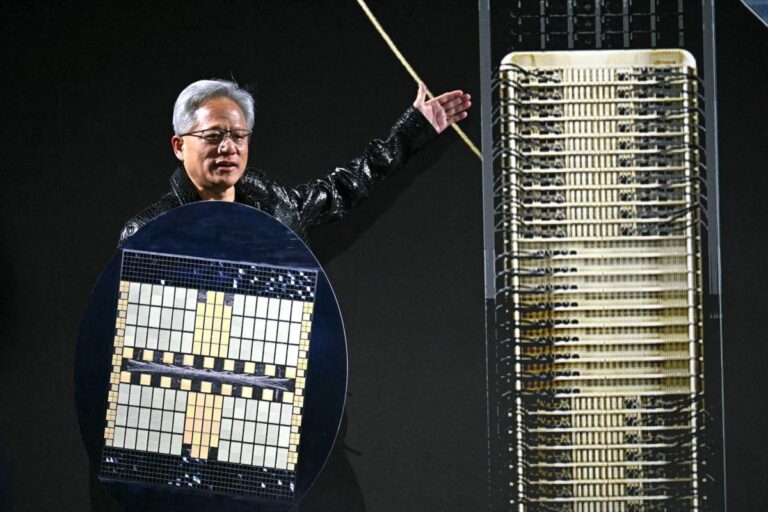“The age of AI Agentics is here,” Huang told the crowd, describing the shift from generative to agentic AI – a future driven by intelligent AI agents capable of helping in tasks in all sectors. Huang called this emerging sector a “multi-billion dollar opportunity,” putting Nvidia at the forefront of the movement.
Huang’s keynote speech was also accompanied by important hardware announcements. Nvidia presented the RTX Blackwell Family of GPUs, offering what Huang described as game-changing performance improvements at lower prices. The highlight was the GeForce RTX 5070, which Huang said matches the performance of the previous generation. RTX 4090 but only costs $549, much less than the 4090’s $1,599 introductory price.
“This is impossible without artificial intelligence,” Huang said, attributing the price-performance breakthrough to AI-driven efficiencies.
The keynote speech opened with a video demonstrating the growing role of AI in everyday life. From AI-based safety features in cars to cartoon-style robots comforting children during doctor visits, video profiles AI agents integrating into healthcare, mobility and personal well-being. He also highlighted the potential of AI to “restore what we have lost,” showcasing people regaining speech and mobility thanks to AI-based technologies.
Taking the stage wearing a flashy jacket, Huang greeted the audience by joking about his style by saying, “I’m in Las Vegas after all,” before revisiting Nvidia’s journey from its founding in 1993 to inception of the world’s first programmable GPU. Huang recalled the company’s early work with Sega. Virtua Fighterusing side-by-side images and a demo video to show how Nvidia’s graphics technology has evolved: from blocky fighters to hyper-realistic digital characters.
“We invented the programmable GPU and that marked the beginning of more than 20 years of incredible advancements,” Huang said as he walked through Nvidia’s most crucial milestones.
But the focus quickly shifted to Nvidia’s future. The RTX Blackwell series, Huang said, features 92 billion transistors and Micron’s G7 memory, capable of 1.8 terabytes per second of bandwidth, double the performance of the previous generation. Huang described the engineering as “a miracle,” emphasizing how GPUs are designed to handle graphics and AI workloads simultaneously.
-
RTX5070 — Offers the performance of the RTX 4090 at $549significantly reducing the premium price of the previous generation.
-
RTX 5070Ti — Offers performance similar to 4090 to $749featuring 1,406 AI TOPS and 16GB of G7 memory.
-
RTX5090 — The top model with 3,404 AI TOPS and 32 GB of G7 memory, retailing for $1,999.
-
RTX5080 – Mid-range option with 1,800 AI TOPS and 16 GB of G7 memory, priced at $999.
-
RTX Blackwell Laptops — Laptops powered by Blackwell RTX GPUs, delivering 40% longer battery life and twice the performance with half the power, ranging from $1,299 – $2,899.
Nvidia’s new RTX GPUs introduce technologies like RTX Neural Shaders and RTX Neural Face, which use AI to improve rendering and create more realistic human faces, while RTX Mega Geometry improves environmental details and Reflex 2 reduces the latency.
Another major advancement demonstrated at CES was DLSS 4, Nvidia’s latest AI-based upscaling capable of generating multiple images at once. In a demonstration, DLSS 4 rendered a scene at 247 frames per second (FPS), more than eight times faster than without AI, while maintaining latency at just 34 milliseconds.
Huang also introduced Project Digits, a personal AI supercomputer that will allow AI researchers, data scientists, and students to access the power of Nvidia’s Grace Blackwell platform right from their desktop (and it solicit official names for the device if you have an idea).
Project Digits is powered by the GB10 Grace Blackwell superchip, which delivers a petaflop of AI computing performance for prototyping, fine-tuning and running large AI models, Huang said.
“AI will be pervasive in every application across every industry. With Project Digits, the Grace Blackwell Superchip will be available to millions of developers,” Huang told the crowd. encourage them to get involved and shape the
the era of AI.
Nvidia’s push into autonomous machines also took center stage when Huang unveiled “Cosmos,” a new core model designed to advance physical AI, or AI that operates in the real world, such as autonomous vehicles or robotics. Cosmos generates synthetic data to train AI systems, accelerating their ability to navigate and adapt to real-world environments.
Huang announced a partnership with Toyota to integrate Nvidia’s AI systems into the automaker’s autonomous vehicle development.
“A trillion miles traveled around the world every year, all of that will be either highly or completely self-sustaining,” Huang said. “I predict this will probably be the first multi-billion dollar robotics industry.”
Cosmos is part of Nvidia’s Omniverse expansion, supporting industrial applications in simulation, robotics and autonomous systems. In one of the most memorable moments of the keynote, Huang stood on stage surrounded by autonomous robots, a scene that echoed the futuristic technology of Iron Man.
The robots flanked Huang as he described Nvidia’s advances in AI-based automation, reinforcing the company’s leadership in developing AI that interacts with the physical world.
While generative AI excels at creativity and automation, agentic AI functions more like a digital assistant, capable of managing workflows, solving problems, and providing real-time assistance in industries such as human resources, software engineering and medicine.
On Monday, Huang declared that we were officially entering the era of agentive AI.
“AI agents are the new digital workforce,” he said, predicting that different agents will change the way we work.
“The IT department of every company will be the HR department of AI agents in the future.”
More reading on Jensen Huang and Nvidia:
This story was originally featured on Fortune.com

